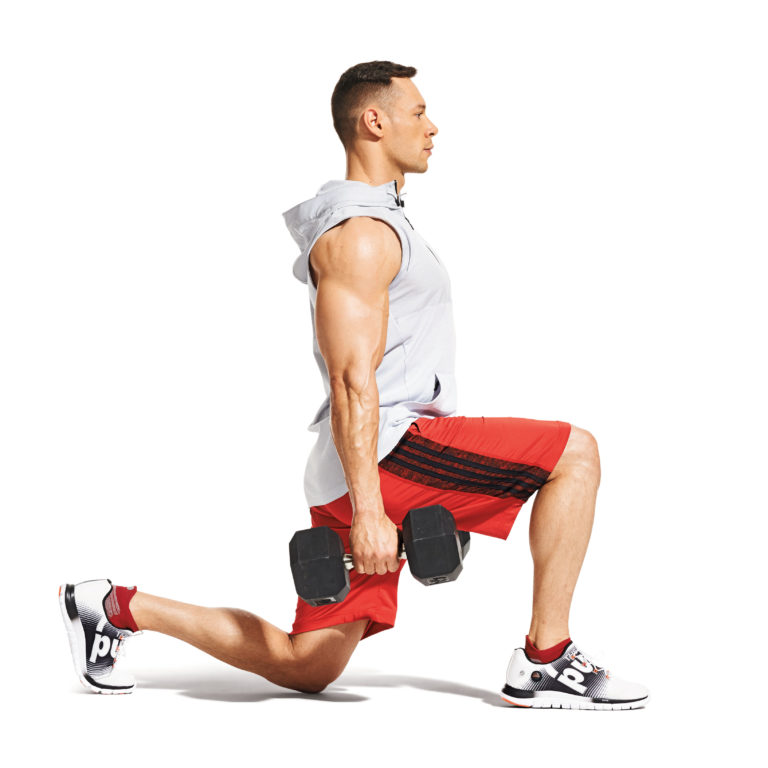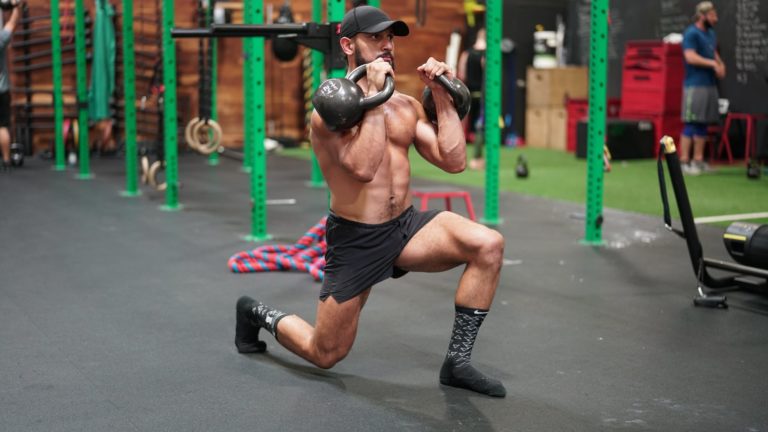The lunge is a staple resistance training exercise that works the hips, glutes, quadriceps, hamstrings, and core. It is a common weight training exercise that has many variations.
Lunges are a common resistance training exercise for strengthening the quadriceps, the gluteus maximus, and hamstrings. A long lunge emphasizes the use of the glutes whereas a shorter lunge emphasizes the quadriceps.
Agonist muscles
- Gluteus maximus, medius and minimus
Prime movers
- Quadriceps: Vastus medialis, lateralis, intermedius and rectus femoris
Synergist muscles
- Adductors, gastrocnemius, soleus, fibularis longus & brevis, hamstrings (biceps femoris, semitendinosus, semimembranosus)
Core
- The abdominals, (rectus abmonius, transverse abdominus and obliques) and lower back are all involved in stabilizing the lifter as they move throughout the full range of motion in the lunge.

Step-by-Step Instructions
- Stand tall with feet hip-width apart. Engage the core.
- Take a big step forward with the right leg. Start to shift the weight forward so heel hits the floor first.
- Lower the body until right thigh is parallel to the floor and right shin is vertical. It’s OK if knee shifts forward a little as long as it doesn’t go past right toe. If mobility allows, lightly tap the left knee to the floor while keeping weight in the right heel.
- Press into right heel to drive back up to starting position.
- Repeat on the other side.
Variations
Below are eight (8) lunge variations that can be used to keep training varied and progressive.
Weighted
Add weights: Barbells, one or two dumbbells, a kettlebell, or anything else you can find. (Can even be uneven)

Walking
Perform a forward lunge and at the low point of the lunge, instead of returning to starting position, shift your weight forward and drive the front heel into the floor. Rise up and bring the back foot forward to meet front foot. Repeat on the other side as you continue to move forward.

Reverse
Stand with the feet hip-width apart, engage the core, and take a big step backward. Activate the glutes and bend the front knee to lower the body so the back knee lightly taps the floor while keeping the upper body upright. Drive front heel into the floor to return to starting position. Repeat on the other side.

Lateral Lunge
From the starting position, take a big step to the right with the right foot, keeping the toes forward and feet flat on the floor. Send hips back, shift weight into right heel, and extend arms in front for balance. Push off right heel to return to starting position, then repeat on the other side.
Curtsy Lunge
With hands on hips and feet wider than hip-width apart, step left leg behind right leg. Bend right knee, engage glutes, and lower until right thigh is parallel to the floor. Lightly tap left knee to the floor. Drive right foot into the floor to rise to starting position. Repeat on the other side.
Clock Lunge
Lunge in all four directions on each side. Lunge forward with right foot, lunge laterally with right foot, reverse lunge with right foot, and then curtsy lunge, bringing right foot behind you. Repeat on the other side.
Walking Lunge Stretch
Perform a walking lunge by stepping right foot forward. At the bottom of the movement, hover the left knee just above the floor and twist from your hips to the right over right knee. Place the hands on knee to help deepen the stretch. Hold for 2 seconds. Press into right heel and bring left foot to meet right to return to standing. Repeat on the other side.
Lunge Jump
A power version. Stand with feet hip-width apart. Instead of stepping, jump into a forward lunge position with right foot forward. Drive right heel into the floor to explosively jump up. Switch legs in midair to land with left leg forward. Immediately lower into a lunge on the other side. For momentum, pump arms as if you’re running.

Common Mistakes
Too Narrow
Avoid bringing the front foot directly in line with the back foot during the lunge, as if walking on a tightrope. This reduces stability and balance. Start with feet hip-width apart and maintain that gap during the lunge.
Front Heel Lift
Lunge forward enough so that the front heel won’t lift off the floor. If the step is too shallow, the knee will travel forward past the foot, which puts unnecessary stress and strain on the knee. Take a larger step, plant the heel, and drive it into the floor to return to starting position.
Upper Body Drop
During a forward lunge, the weight is shifting forward. During this it is important to maintain an upright upper body, and avoid leaning forward, which will put added strain on the knee. This is especially important if lunging with weight. Engage the torso muscles, pulling the belly button toward the spine and keep the eyes forward rather than looking down.
Check out these other resistance training exercises:
- Face Pull
- Bench Press
- Turkish Get Up
- Front Squat.
- Shoulder Press – Standing Barbell
- Deadbug – Abdominal Exercise
- Monster Walk
- Overhead Squat
- Battle Rope
- Goblet Squat
- Swiss Ball Hamstring Curl
- Seated Cable Row
- Ab Roller
Learn more about resistance training by studying a Certificate III in Fitness, Certificate IV in Fitness, or Diploma of Fitness with Fit Education.
